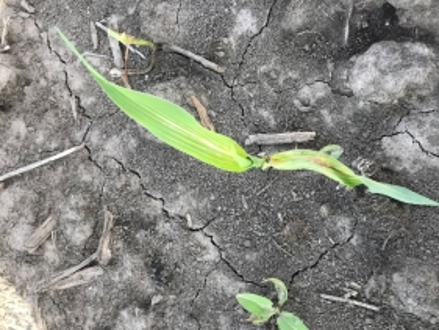
Herbicide carryover isn’t something farmers have to worry about too often. But this season could be an exception for areas of the Midwest that have been dry since fall, especially west of the Mississippi River.
“Temperatures and moisture have the biggest influence on the breakdown of chemicals,” says AgriGold Agronomist Jason Mefford. “Last spring we saw a fair amount of herbicide carryover after the drier 2022 season. And we are much drier heading into the 2024 growing season.”
Farmers need to have herbicide carryover on their radar and be ready to make adjustments that limit their risk.
Identify at-risk fields
Start by determining which fields are most at risk of herbicide carryover, Mefford advises. That largely hinges on soil type and the chemistry used.
“Fields with lighter, sandier soils with lower cation exchange capacity (CEC) scores are more apt to have herbicide carryover amid dry conditions,” Mefford says. Low organic matter also raises the risk.
The next consideration is the chemistry used, as some modes of action are more prone to carry. Mefford is most concerned about three of them.
His first concern is with some of the p-hydroxyphenylpyruvate dioxygenase (HPPD) herbicides used on corn. “Those Group 27 chemicals can hang out pretty easily in this dry weather,” Mefford says.
The protoporphyrinogen oxidase (PPO) inhibitors of Group 14 are another concern because some of them are sprayed on soybean fields late in the year. “If you get into a long, dry year, that chemical can persist, causing problems with corn.”
The third scenario Mefford is worried about is stacking of Group 2s, or acetolactate synthase (ALS) inhibitors. “A lot of those are used for fall burndown because they have a good residual and do a nice job cleaning up fields,” he says.
“But when it’s dry, these herbicides can linger. If your 2024 chemical program for soybeans happens to have ALS, you may compound the problem,” Mefford explains. “In that case, make sure you’re planting sulfonylurea-tolerant soybeans (STS). You should also be mindful not to stack ALS chemistries in fields going to corn.”
Adjust your management strategy
Farmers with fields at high risk of herbicide carryover could consider switching their rotation to match what was planted last year,” Mefford says. “That depends on many factors, including whether anhydrous has been applied last fall and disease history.”
Another option is to disc, diluting the layer of chemical with more soil, Mefford continues. Again, that’s not an option for everyone.
Backing off seeding populations can also help. “Giving plants extra space tends to lead to better plant health,” Mefford explains. “A healthy plant will always do better than one that’s struggling.”
Scout fields and manage accordingly
While Mefford doesn’t anticipate herbicide carryover leading to many replant situations, impacted plants are more susceptible to stress or drought later in the season. “Weed control can also be an issue with herbicide-stunted plants,” he adds.
Herbicide carryover injury isn’t something you see across a field. Mefford details, “Issues are most likely to show up at field entrances, areas where application overlaps, like corners, and lighter areas of the field, such as a hillside.
“If farmers have at-risk fields, they may want to gauge the extent of any damage before deciding how to manage that crop moving forward,” Mefford says. “Don’t throw the kitchen sink at it if there’s a lot of damage.”
When the plants emerge, look for signs of herbicide carryover damage. Some of the main symptoms include stunting, chlorosis (yellowing tissue) and necrosis (dead tissue). “Shortened internodes are more specific to ALS chemistry,” Mefford details. “HPPD chemistries tend to lead to bleaching of the leaf, especially in soybeans.”
Evaluate your chemical plans for the 2024 season
To protect against future issues, farmers should evaluate what chemistries they’re using this season and compare those to 2023. “Don’t start stacking those chemistries and compounding the problem,” Mefford explains.
“Reevaluate your plans and swap things out if needed,” he continues. “Even if you’ve already bought your chemical, this review is time well spent.”
Don’t hesitate to ask for help. “As agronomists, we’re always eager to help a farmer with questions on herbicide carryover or any other issues,” Mefford says. “We take pride in being champions for our farmer customers.”

















